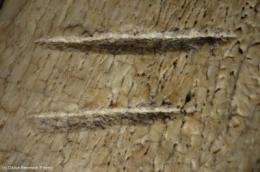November 16, 2010 report
Anthropologist challenges Lucy’s butchery tool use

(PhysOrg.com) -- An anthropologist in Spain has challenged recent evidence the ancient hominin species Australopithecus afarensis, represented by "Lucy," used sharp stones to butcher animals for meat some 800,000 years before the earliest known use of such tools.
Manuel Dominguez-Rodrigo from Complutense University of Madrid and colleagues, say the marks found on two fossilized animal bones that were presented as evidence of butchery tool use were more probably caused by the animals being trampled by other animals.
The fossilized bones, approximately 3.4 million years old, were found in the Dikika area of the Lower Awash Valley in Ethiopia, and had several incisions. The scientists who found the fossils concluded the marks were made by sharp stones like those found locally, which were used to slice the meat off the carcass. Their paper was published in Nature in August this year and reported in PhysOrg.
This conclusion has been challenged by Dominguez-Rodrigo’s group, who say the marks resemble damage produced by experimental trampling, and the evidence that Australopithecus, a creature with similar-sized brains to modern chimpanzees, was using stone tools to butcher animals 3.4 million years ago is “currently unsupported.”
The damage on the bones was compared to damage produced by a trampling experiment in 2009 in which three men of varying sizes trampled across deer bones placed in a sand bed of a similar sand mix to that existing in the fossil find location. The men wore shoes with soles covered by coarse grass and trampled the bones for two minutes. The trampling produced long, thin incisions with a flat-based V, or _/-shaped cross-section, which Dominguez-Rodrigo said were rarely found in animal butchery using stone tools. The trampling marks were also curved, like the marks on the Dikika fossils, whereas butchery marks might be expected to be straight.
One of the scientists involved in the original research, Curtis Marean, an archaeologist from the Arizona State University, rejected Dominguez-Rodrigo’s assertions, saying the trampling experiment assumed Australopithecus was using stone tools rather than sharp stones found locally. He also said that while some of the marks resemble those on the experimentally trampled bones, there were two deep incisions known as A1 and A2 on one of the fossils, and they closely resemble butchery marks rather than trampling marks. Dominguez-Rodrigo agreed these marks were similar to cut marks made by stone tools, but rejected the conclusion because of the doubts raised by the trampling experiment.
Leader of the original team, Paleolithic archaeologist Shannon McPherron from the Max Planck Institute for Evolutionary Anthropology at Leipzig in Germany, added Dominguez-Rodrigo’s criticisms were based only on an examination of the photographs of the fossils and he had not examined the actual specimens.
Dominguez-Rodrigo also said the fossils found in Dikika were discovered on the surface and could have been damaged by abrasive soil. If they had originated in a sand bed, as Marean’s group argued, animal trampling could have occurred and produced many of the cuts attributed to stone tools.
The new paper is published in the Proceedings of the National Academy of Sciences (PNAS).
More information: Configurational approach to identifying the earliest hominin butchers, Manuel Domínguez-Rodrigo et al., PNAS, Published online before print November 15, 2010, doi:10.1073/pnas.1013711107
© 2010 PhysOrg.com





















